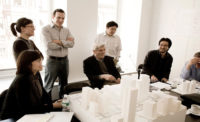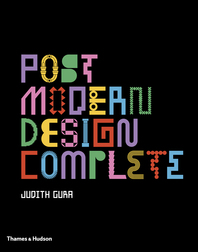Charles Gwathmey, the notable New York architect, once wrote, “I have always believed that constraints are the seeds of invention.”
In that case, he was referring to his 1997 addition and renovation of the Henry Art Gallery in Seattle—a typically precise intervention of Modernism on a Beaux Arts structure. But constraints, often literally physical, defined much of his most notable public projects, among them a 1970 renovation of Whig Hall at Princeton University, the 1992 addition to Frank Lloyd Wright’s Guggenheim, and the 2007 renovation and addition to Paul Rudolph’s Art and Architecture Building at Yale. In each of those cases, Gwathmey and his longtime business partner Robert Siegel were given the task of contending with some of the most complex architectural precedents of the 20th century. At the same time, Gwathmey’s extensive domestic portfolio, which he remained earnestly committed to throughout his career, often seemed constrained by history. In his houses, architectural memory—in particular the precedents of Le Corbusier—was processed and reemerged in a collage of unrelenting geometries.
Gwathmey, after a long battle with esophageal cancer, died on August 3 in Manhattan at the age of 71. He is survived by his wife, daughter, and stepson. A small funeral was held last weekend and plans are being made for a public memorial service in New York in the near future.
Born in 1938 in Charlotte, North Carolina, Gwathmey attended the High School of Music and Art in Manhattan and, from 1956 to 1959, the University of Pennsylvania, moving to Yale to complete his master of architecture degree in 1962. After graduation, he traveled to Europe on a Fulbright grant to study, among other things, the work of Le Corbusier, and returned to New York to launch his career. At the time, Siegel, a high school acquaintance, was working in the office of Edward Larabee Barnes and recommended that Gwathmey join him.
In 1965, Gwathmey left Barnes’s firm to design a residence (with then-partner Richard Henderson) for his own parents in Amagansett, Long Island. The 1,200-square-foot house would prefigure a prolific career in residential design. Located on a flat, one-acre field with ocean views, the house sits on the land like a sculpture, combining Modernist functional strategies with a formal collage of platonic solids that create a series of bold interior spaces. In his 1992 book, Gwathmey Siegel: Houses, Gwathmey explained that the house “clarified for me that architecture doesn’t have to be big to have presence or content,” adding, “as in all our houses, it is the section rather than the plan that is the primary space definer.” That spatial dynamism was noted and admired at the time as a fresh and original interpretation of Modernist tradition, which had become staid by the mid 1960s. Many still consider the Gwathmey Residence to be his best project.
Shortly after, in 1968, Gwathmey received a commission to design a student dormitory at the Purchase campus of the State University of New York, as part of a Barnes masterplan. His partnership with Henderson had dissolved and he invited Siegel, who had amassed experience with large buildings in six years with Barnes, to form a partnership that would last 41 years. Gwathmey Siegel and Associates, in its long history, has completed more than 400 projects for a vast array of clients.
Describing their creative process, Siegel says he and Gwathmey “worked literally across a big desk and would develop the partis together, regardless of the scale of the project.” After that initial investigation, one partner would typically take the lead—Gwathmey tended to stick to smaller, residential work where he could explore an artistic vision in-depth, leaving the larger and more conventional public projects to Siegel. (Siegel recalls that working closely with a single client suited Gwathmey’s temperament well, allowing him to develop projects in detail.) Given this collaborative approach, Gwathmey’s death raises questions about the future of the firm, which currently has many projects, both public and private, on the boards. In Manhattan alone, buildings under construction include a hotel in Midtown, a hotel near the World Trade Center site, and a building for the United States Mission to the United Nations. Pending an agreement with the executors of the Gwathmey estate, Siegel intends to continue the work of the 65-member practice.
Aside from his firm’s work, a defining aspect of Gwathmey’s career was his association with Peter Eisenman, Michael Graves, John Hejduk, Richard Meier—together known as The New York Five—who anointed themselves re-inventors of Modernism with their 1972 publication, Five Architects. Gwathmey, however, distinguished himself immediately from the more hermetic tendencies of the rest of the group, who were criticized for a lack of concern with the specifics of built work. Robert Stern noted this in a 1973 critique in Architectural Forum, writing, “in his sympathy for the particulars of places, he alone seems concerned with the materiality of buildings.” This skill was also noted in RECORD’s coverage of the 1970 Cooper House: “the strong and simple forms . . . while constantly reminding us of the geometry that determines them, are also essentially functional and in keeping with the uses and activities that they contain.”
Gwathmey’s balance of a strong architectural vision with a deference for pragmatic concerns—he was particularly skilled at satisfying his clients’ programmatic and personal needs—led to the flourishing of his domestic portfolio, with such clients as Steven Spielberg, David Geffen, and the de Menil family. A Gwathmey house, according to Paul Goldberger, became “the 1980's badge of success that a great Georgian mansion by Delano & Aldrich had been in the 1920's.” In these increasingly elaborate works, he was able to expand from the object quality of the early house for his parents into more complex, expansive estates, often encompassing several structures. But the formal language remained throughout his career.
The same balance of singular point-of-view and humility defined the public work Gwathmey did contribute to, with more varied outcomes. Compared to the residential projects, the public work was placed in a more treacherous setting—most notably in the renovations and additions to the Guggenheim Museum in New York (1992) and Paul Rudolph’s Art and Architecture Building at Yale (2007). In both cases, Gwathmey played a large role, and a drawn-out design process led to a series of often-maligned compromises, ones that arguably stemmed from Gwathmey and Siegel’s willingness to accommodate the conflicting forces around them. The projects fell prey to similar criticisms; they were at once too strong and too weak, honoring tradition to a fault, but still wanting to make a statement of their own. The two architects’ ability to negotiate these realms—an openness to suggestion and a willingness to bend—was perhaps the same quality that made it so difficult to create a convincing counterpoint to the existing monuments with which they had to contend.
Such criticisms were often distressing for Gwathmey to read, and he was known to reply to harsh writers with a letter filled with strong invective of his own. That emotional engagement was a rare thing in the stoic architectural field—he said, for instance, that concern over the Rudolph addition at Yale would keep him up at night. But, ultimately, that concern came out of an abiding ardor for the tradition of Modernist architecture, perhaps best expressed in his Glenstone private museum and residence in Maryland, completed in 2008. There, he placed an array of citations to 20th century masters—Corbusier, Mies, Loos, Aalto, and Robert Mallet-Stevens—through a vast 125-acre campus. In the June 2008 issue of RECORD, Suzanne Stephens wrote, “the compound pays homage to various design elements in Modern architecture past, as if Gwathmey were exploring a genealogical legacy that he reveals in telling traces.” Initially placed in that group of five who chose to challenge history, Gwathmey’s work, the good and the less so, betrays his true place: the avid student, who gave the best answer he could.










Post a comment to this article
Report Abusive Comment